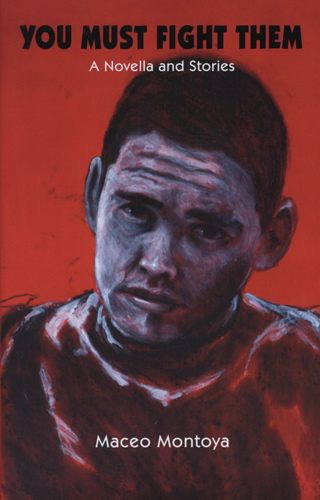You Must Fight Them
Maceo Montoya’s You Must Fight Them, a debut collection which begins with the namesake—a ninety-nine-page novella, in which Chicano stereotypes are deciphered, defined, mocked, challenged and rendered in heart-shattering detail—is poignant and entertaining. Montoya’s narrators are mostly bookish and well-educated. They are searching for identity and often do not find what they are expecting. The doctorate student is supposed to be tough and fight the brothers of a girl he worshipped in high school. Why tough? Why fight? Because that is how it is and always will be. Lupita, the girl, wants out of this macho-viciousness, but can’t figure out how. Nothing is cut and dry. Montoya deals with smudged borders and crooked lines.
Maceo Montoya’s You Must Fight Them, a debut collection which begins with the namesake—a ninety-nine-page novella, in which Chicano stereotypes are deciphered, defined, mocked, challenged and rendered in heart-shattering detail—is poignant and entertaining. Montoya’s narrators are mostly bookish and well-educated. They are searching for identity and often do not find what they are expecting. The doctorate student is supposed to be tough and fight the brothers of a girl he worshipped in high school. Why tough? Why fight? Because that is how it is and always will be. Lupita, the girl, wants out of this macho-viciousness, but can’t figure out how. Nothing is cut and dry. Montoya deals with smudged borders and crooked lines.
In the second story, “A Brief Explanation,” a strict professor of an elite east coast college is nudged from teaching Mexican-American History into a “more entertaining” seminar on Latino Gangs, which grows in popularity, until the professor is falsely blustering his “street cred” by mistakenly inviting members of opposing gangs to his class on the same day. Montoya is holding a mirror up to reveal the intricacies and traps that come from turning popular cultures into academic fodder. The story is written as a confession, an explanation of how the professor unraveled. “Aren’t we all a little guilty of self-mythologizing?” his wife asks at the end of the story and the reader realizes that hubris is inescapable.
In “How I Broke Up with The Mayor,” we see a writer who rents a room transform into a modern-day butler, then caretaker, and eventually unravel into a thug, basically, the pawn of a richer, more powerful man, unawares:
“You’re the only one I can really count on. You’re more than a friend, you’re like—well like—well, I’ll say it. You’re like my consigliore. You take care of business, you’re no nonsense, you’re dependable. A man like me doesn’t get anywhere without someone like you beside him.” And with that he handed me a ski mask and a crow bar.
Montoya subverts expectations; loyalty and honor are used as bait. His characters—and especially narrators—are alive and have to make difficult decisions to survive. In the shortest and perhaps most risky story, “The Stuttering Roommate,” the narrator is so unlikeable, he is almost comic:
When you have to live with five other guys in an apartment the size of your last crap, it’s best that a few of them are quiet and mind their own business.
Then, the narrator goes on to tell the most unsympathetic story, all the while looking for sympathy. It’s more than the kettle calling itself black. It’s how understandably cold a heart can become when pushed to extremes. In this case, loneliness creates an inhumane lack of sympathy, rarely felt in modern fiction. This narrator is so unlikeable, he’s almost likeable—a true anti-hero.
In “Cesar Trejo’s Knuckles,” a construction worker is called to his local bar weekly to patch the drywall above the urinal in which drunken clients are continually punching holes. The repaired wall gets stronger and stronger, as does the narrator’s obsession with the men who are punching the holes. At one point the dry-waller begins confronting the punchers. They deny the vandalism, they avoid the question until, eventually, one vandal just states the truth, “Man, I don’t know why. I just did.” The obsession continues until the worker’s curiosity becomes stranger than the urge to vandalize.
Montoya’s short stories are tight, witty and insightful. Even when told by a limited point of view, a complete and diverse universe expands around the plot. And although, most of the stories take place in a specific Mexican-American community in Woodlands, California, like Joyce’s Dubliners, a universality comes blazing through, as if by analyzing one microscopic corner of contemporary California, we can feel bonded to and amazed by the lives of others who cross our paths daily.





